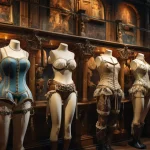
The Fabric of the 1940s: Textile Innovation and Style
🌟 The Fabric of the 1940s: Textile Innovation and Style 🌟
In the midst of the tumultuous 1940s, as the world grappled with the upheaval of World War II, a unique chapter in the history of fashion unfolded. The fashion landscape of this era was not merely a canvas for sartorial creativity; it was a reflection of resilience, resourcefulness, and remarkable innovation. 🌍✨
The 1940s witnessed a world at war, where fabric rationing became a stark reality. In the face of these challenges, the fashion industry didn’t wither; instead, it flourished with an unwavering spirit. Fabric rationing imposed limitations, but from within these constraints emerged a surge of creativity like no other. 🧵🔍
1940s Textile Innovation is the key to understanding this era’s fashion evolution. It’s a journey through time that takes us from the scarcity of materials to the abundance of creativity. In this article, we embark on a captivating exploration of how textile innovation in the 1940s profoundly influenced fashion. 🕰️👗
But first, let’s set the stage for this grand narrative, where the stage is the world itself, and the actors are the designers, seamstresses, and fashionistas who defied the odds to craft a story of style and substance. We’re about to delve deep into a world where fabrics become not just materials but symbols of determination and ingenuity. 🎭✂️
So, my fellow fashion enthusiasts, fasten your seatbelts as we step into a bygone era, where the threads of history are woven into the very fabric of fashion. Let’s embark on a journey through the 1940s, where every garment tells a story of resilience and creativity. 🌟👚
Rayon’s Remarkable Rise
Ah, ladies and gentlemen, welcome to the heart of our journey into the 1940s fashion landscape. We find ourselves amidst the remarkable rise of a textile that played a pivotal role in shaping the style of the era—rayon. 🌟🧵
Origins and Characteristics
Let’s begin with the origins and characteristics of rayon. This textile, often referred to as “artificial silk,” was the result of an inventive fusion of natural and synthetic elements. Rayon brought a touch of luxury to everyday clothing without the hefty price tag of silk. Imagine, a fabric that could mimic the sheen and drape of silk, all while offering affordability and accessibility. It was a game-changer. 🌿🧣
Popularity in 1940s Fashion
Now, let’s talk about rayon’s meteoric rise in the 1940s fashion scene. The fashionistas of the time couldn’t get enough of it. Its lightweight and breathable nature made it ideal for warm-weather clothing, and it quickly became a staple in women’s dresses, blouses, and even undergarments. The shimmering allure of rayon captivated fashion-conscious individuals, offering an elegant yet practical choice during a challenging era. ✨👗
Versatility and Style Evolution
Rayon’s versatility knew no bounds. It wasn’t confined to one particular style; instead, it seamlessly adapted to various fashion trends of the 1940s. Whether it was the tailored suits of the early ’40s or the flowing, feminine silhouettes of the later years, rayon was there, lending its graceful touch to every design. Its chameleon-like ability to take on different forms made it a beloved textile for designers and wearers alike. 🌈👒
Ladies and gentlemen, as we continue this journey, remember that rayon was just the beginning of textile innovation in the 1940s. There’s more to uncover, more stories to tell, and more fabrics that left their indelible mark on this era of fashion. Stay with us as we explore further into the fascinating world of 1940s Textile Innovation. 🕰️✂️
Nylon’s Debut and Impact
Ladies and gentlemen, we continue our journey through the 1940s fashion tapestry, we delve into the groundbreaking emergence of a textile that revolutionized the world of fashion—nylon. 🌟🧶
The Emergence of Nylon as a Groundbreaking Textile
Our story begins with the emergence of nylon, a synthetic material that would forever change the textile landscape. In the late 1930s, this innovative material made its debut, and its impact was nothing short of extraordinary. Designed to be strong, durable, and versatile, nylon was initially developed for industrial purposes, but it didn’t take long for the fashion industry to recognize its potential. 🌐🌪️
Nylon’s Immediate Impact on Fashion
Fashionistas of the 1940s welcomed nylon with open arms. The textile industry saw it as a game-changer, and rightfully so. Nylon stockings, in particular, became an instant sensation. They were sheer, lightweight, and had an alluring shimmer that captured the imagination of women across the globe. Nylon’s availability and affordability compared to silk stockings meant that elegance was no longer reserved for the elite; it was within reach for everyone. 👠✨
How Nylon Influenced Undergarments and Hosiery
But nylon’s influence didn’t stop at stockings. It also played a pivotal role in shaping the world of undergarments. Brassieres, known as “bras” today, evolved with the introduction of nylon. The fabric offered comfort and support while maintaining a delicate appearance. In essence, nylon revolutionized not just fashion but also women’s comfort and confidence. 🩲🌹
Nylon’s impact on the hosiery and undergarment industry was so profound that it’s hard to imagine the 1940s fashion landscape without it. It’s a testament to the power of innovation and the ability of textiles to shape not only the way we dress but also the way we perceive ourselves. 🧦👙
As we move forward in this journey, remember that the 1940s were a period of transformation and adaptation. The textiles of the time were not just fabrics; they were agents of change, redefining the very essence of fashion. Stay with us as we unravel more threads of history, more stories of innovation, and more moments of sartorial brilliance. 🕰️✂️
Wool and Its Role in War Efforts
Welcome back, my fashion-forward friends, as we delve deeper into the fabric saga of the 1940s. In this section, we turn our attention to a textile that played a pivotal role during wartime—wool. 🌟🐑
Wool’s Significance During Wartime
Wool, a natural and versatile textile, took center stage during the tumultuous years of World War II. Its significance was twofold. Firstly, wool was a crucial component of military uniforms. Its insulating properties kept soldiers warm in the harshest conditions, making it an essential fabric for those serving on the frontlines. 🧥❄️
Secondly, wool was deeply intertwined with the civilian effort on the home front. Governments encouraged citizens to contribute to the war effort by donating wool garments. These donations were repurposed into military supplies, including blankets, socks, and scarves, providing comfort and warmth to those in service. Wool symbolized not only practicality but also patriotism. 🇺🇸🌏
Adaptations Made in Wool Fashion
As the world’s focus shifted towards the war, fashion had to adapt. Wool, being a versatile textile, found itself at the forefront of these adaptations. Designers and manufacturers had to create functional yet stylish clothing that met the challenges of the era. Suits, for instance, became more streamlined, using less fabric without sacrificing style. Utility dresses and suits emerged, designed with practicality in mind. 🧵👜
The wartime restrictions on fabric consumption led to the “make do and mend” mentality, where people creatively repurposed and repaired wool garments. It was an era of resourcefulness and resilience, and wool was at the heart of this transformation. 🧶🪡
The Enduring Legacy of Wartime Wool Garments
Even after the war’s end, the legacy of wartime wool garments endured. These garments, born out of necessity, continued to influence fashion. The streamlined silhouettes, practical designs, and innovative use of wool left an indelible mark on post-war fashion. Elements of utility clothing and a sense of conservation persisted in the fashion consciousness. 🌅👚
As we navigate this journey through the 1940s, remember that textiles like wool were not just materials for clothing; they were threads in the tapestry of history. They symbolized courage, adaptability, and the human spirit’s ability to find beauty and innovation even in the face of adversity. Stay tuned for more as our fabric adventure unfolds. 🕰️✂️
Silk and Its Luxurious Allure
Welcome back to our fashion odyssey through the 1940s, where each textile we explore is a chapter in the grand narrative of style and resilience. In this section, we’re about to immerse ourselves in the world of silk—a fabric synonymous with luxury and sophistication. 🌟🧵
Silk’s Role in 1940s Fashion
Ah, silk! It’s a textile that has captivated humanity for centuries, and the 1940s were no exception. Silk had a vital role to play during this era, offering a touch of opulence amid the backdrop of wartime challenges. Its smooth, lustrous surface and lightweight nature made it an ideal choice for clothing. But it wasn’t just about aesthetics; silk had practical qualities too. Its breathable and moisture-wicking properties made it comfortable in both warm and cool weather—a true ally for those navigating the complexities of the time. 🌬️👗
The Use of Silk in Eveningwear and Accessories
Silk wasn’t content with being just another fabric; it elevated fashion to new heights. Evening gowns adorned with silk exuded glamour and sophistication. Picture this: cascading silk chiffon, shimmering under the dim lights of a ballroom, as couples swayed to the music. It was an era when silk was synonymous with elegance, and no red carpet or cocktail party was complete without it. ✨🌙
Silk wasn’t limited to clothing; it wove its way into accessories as well. Silk scarves, gloves, and handbags became essential fashion elements. These accessories not only complemented outfits but also showcased the wearer’s refined taste. Silk symbolized not just luxury but also a sense of occasion—a rare commodity during challenging times. 🧣👜
How Silk Symbolized Elegance in a Challenging Time
In the grand tapestry of the 1940s, silk was more than just a textile. It was a symbol of elegance in the face of adversity. As the world grappled with uncertainty, silk provided a sense of normalcy and sophistication. The mere act of wearing silk garments or accessories was an affirmation of style and grace, a way to resist the upheaval of the era. 🌹🌆
Ladies and gentlemen, silk’s allure transcended fashion; it was a statement of resilience, an ode to beauty in turbulent times. As we continue this journey, remember that the 1940s were a testament to human creativity, where even amidst challenges, elegance and luxury found their place in the world of textiles. 🕰️✂️
Cotton’s Comfortable Resilience
Ah, folks, we’re continuing our captivating journey through the 1940s, where textiles aren’t just fabrics; they’re symbols of an era’s spirit and adaptability. In this section, we’re about to immerse ourselves in the world of cotton—a textile known for its comfortable resilience. 🌟🌾
Cotton’s Practicality in Everyday Fashion
Let’s begin with the practicality of cotton in everyday fashion. As the world grappled with the challenges of the 1940s, cotton emerged as a dependable ally. Its softness and breathability made it the go-to choice for casual wear. Cotton shirts, dresses, and separates were comfortable for daily activities, making cotton an essential fabric in the lives of men, women, and children alike. Imagine the feeling of a crisp, cotton shirt against your skin on a warm summer day—practicality met comfort, and style followed suit. ☀️👚
The Adoption of Cotton in Workwear
But cotton’s role extended beyond casual attire. It was embraced in the realm of workwear as well. Its durability and ease of care made it the ideal choice for uniforms and functional clothing. Whether it was factory workers or military personnel, cotton garments were up to the task. Work shirts, overalls, and even uniforms were crafted from cotton, ensuring comfort during long hours of labor. 🏭👷
Cotton’s Continued Relevance in Contemporary Fashion
Now, fast forward to today, and you’ll still find cotton as a prominent player in contemporary fashion. The legacy of cotton from the 1940s endures. Its versatility has transcended time, making it a staple in modern wardrobes. Think of the classic white cotton T-shirt or the timeless denim jeans—both iconic pieces that owe their enduring popularity to cotton’s comfort and resilience. The fabric that stood strong during wartime continues to be cherished in our everyday lives. 🌿👖
Ladies and gentlemen, as we explore cotton’s comfortable resilience, we’re reminded that sometimes, it’s the simplest of fabrics that have the most profound impact. Cotton’s journey from the 1940s to today is a testament to its enduring relevance and the timeless qualities that continue to make it a beloved choice in fashion. 🕰️✂️
The Creative Reuse of Materials
Welcome back to our journey through the 1940s, where every textile tells a story of resilience and resourcefulness. In this section, we delve into a theme that defined the era—the creative reuse of materials. 🌟🧵
Innovations in Recycling and Repurposing Textiles
The 1940s were a time of scarcity, where fabric rationing was a stark reality. But necessity, as they say, is the mother of invention. Innovations in recycling and repurposing textiles took center stage. Nothing went to waste; every scrap of fabric had potential. This resourceful spirit gave birth to imaginative ways of utilizing materials. Old garments were transformed into new ones, and textiles were ingeniously repurposed into quilts, curtains, and more. It was a time when sewing machines were not just tools; they were instruments of creativity and survival. 🪡🧶
The “Make Do and Mend” Mentality During the 1940s
At the heart of this resourcefulness was the “make do and mend” mentality. It was a call to action, a reminder that in challenging times, we adapt, we repair, and we find new purpose in the old. Buttons were swapped, patches were sewn, and garments were altered to fit changing needs. It was a statement of resilience, a refusal to be defined by limitations. The “make do and mend” philosophy wasn’t just about clothing; it was a reflection of the human spirit’s ability to find beauty and value even in the most frugal circumstances. 🧥🪢
How Resourcefulness Influenced Fashion Design
This resourcefulness didn’t just shape individual wardrobes; it influenced fashion design as a whole. Designers embraced utility and simplicity, creating clothing that celebrated functionality without compromising on style. The ethos of the time was about making the most of what you had, and this philosophy seeped into every aspect of fashion, from the runway to the streets. It was a reminder that even in the face of adversity, creativity could thrive. 🌆👗
Ladies and gentlemen, as we explore the creative reuse of materials, remember that the 1940s were a testament to human ingenuity. It was a time when fabric wasn’t just fabric; it was a canvas for resourcefulness, a stage for adaptation, and a symbol of resilience. Stay tuned as our journey takes us into the world of fashion icons and their impact on textile trends.
Fashion Icons and Their Impact on Textile Trends
Welcome back to our enthralling exploration of the 1940s, where fashion isn’t just about fabrics; it’s about the personalities who shaped textile trends. In this section, we’re about to dive deep into the world of fashion icons and their profound influence on the fabrics of the era. 🌟👗
Highlighting Key Fashion Influencers of the Era
First, let’s cast a spotlight on the individuals who left an indelible mark on 1940s fashion. These were the trailblazers, the trendsetters, and the style icons who set the sartorial tone of the era. From Hollywood stars to royalty and fashion designers, the 1940s had no shortage of influential figures. Names like Ingrid Bergman, Katharine Hepburn, and Dior became synonymous with elegance and sophistication. Their choices in clothing and textiles were watched and emulated by millions. 🌟🎬
Their Role in Promoting Specific Textiles
These fashion icons didn’t just wear clothes; they became ambassadors for specific textiles. Their choice of fabrics influenced not only the fashion industry but also the choices of everyday people. Think of how a glamorous Hollywood starlet in a silk gown could ignite a desire for silk in the hearts of women around the world. These icons were walking billboards for the textiles they adorned, turning them into must-have materials of the time. ✨🌐
The Lasting Legacy of Their Style Choices
The impact of these fashion icons didn’t fade with the end of the 1940s. Their style choices left an enduring legacy that continues to influence fashion today. Elements of their timeless elegance can be seen in contemporary designs. The classic silhouettes, the love for luxurious fabrics, and the attention to detail—all these aspects of their style continue to inspire designers and fashion enthusiasts alike. Their choices were not just trends; they were statements of enduring style. 🕰️🌹
As we navigate this chapter of our journey, remember that fashion icons weren’t just individuals; they were cultural forces that transcended time. They reminded us that clothing is not merely a covering for the body; it’s a canvas for self-expression and a reflection of the times we live in.
Post-War Transformations in Textiles
On to our ongoing exploration of the 1940s—a time of resilience, innovation, and transformation. In this section, we step into the aftermath of World War II and witness the profound changes that unfolded in the world of textiles. 🌟🌏
The Shift in Textile Innovation After World War II
The end of World War II brought about a seismic shift in the textile industry. The wartime restrictions and rationing that defined the early ’40s gave way to a new era of possibility. As nations rebuilt and industries recovered, the textile landscape underwent a remarkable transformation. The focus shifted from wartime necessities to peacetime creativity. Innovation surged, and new materials emerged, heralding a fresh chapter in fashion history. 🧵🪙
New Materials and Their Impact on Fashion
The post-war period introduced a host of new materials that revolutionized fashion. Synthetics like polyester and acrylic made their debut, offering durability and affordability. These materials paved the way for innovative designs and a broader range of accessible clothing options. Nylon, which had been primarily reserved for wartime applications, found its way into everyday fashion, adding versatility and sleekness to wardrobes. The fashion industry embraced these new materials, and fashion enthusiasts eagerly welcomed the fresh textures and styles they brought. 🌈👘
How the 1940s Laid the Foundation for Future Textile Developments
But perhaps the most remarkable legacy of the 1940s was the foundation it laid for future textile developments. The innovations, resourcefulness, and adaptations of this era served as a blueprint for the decades to come. The textile industry had learned valuable lessons in efficiency and sustainability, which would shape future textile production and design. The spirit of resilience and creativity that defined the 1940s continued to inspire textile innovations well beyond the post-war period. 🌱🌟
As we conclude this section, remember that the 1940s were a time of profound change, not just in fashion but in the very fabrics that make up our clothing. The end of one era marked the beginning of another, where innovation and creativity were boundless.
Contemporary Resonance of 1940s Textile Innovation
Ladies and gentlemen, as our journey through the 1940s nears its conclusion, we arrive at a fascinating crossroads—the intersection of past and present, where the textiles of yesteryears continue to shape our modern fashion landscape. In this section, we unravel the contemporary resonance of 1940s textile innovation. 🌟👚
Examining How 1940s Textiles Continue to Influence Modern Fashion
The textiles that emerged during the 1940s have left an indelible mark on the fashion world. Today, we see their enduring influence in the fabrics that grace our runways and closets. The durability of nylon, the elegance of silk, and the versatility of cotton—all these qualities continue to inspire designers and fashion enthusiasts alike. Garments that harken back to the style of the ’40s, with their clean lines and classic silhouettes, have a timeless appeal that transcends eras. It’s a testament to the enduring power of innovation and craftsmanship. 🕰️👗
Fashion Designers’ Homage to 1940s Textiles in Their Collections
Fashion designers pay homage to the past through their collections, often drawing inspiration from the fabrics and styles of the 1940s. You’ll find nods to the era’s glamour and resilience on today’s runways. Whether it’s the revival of silk gowns, the creative use of recycled materials, or the incorporation of vintage-inspired textiles, designers celebrate the enduring allure of the ’40s. It’s a beautiful fusion of history and modernity, where the past informs the present. ✨👠
Consumer Nostalgia for 1940s-Inspired Fashion Developments
But it’s not just the fashion industry that embraces the 1940s. Consumers, too, express their nostalgia for this remarkable era through their fashion choices. Whether it’s a penchant for vintage clothing, a love for classic fabrics, or an appreciation for the simplicity and elegance of 1940s style, people continue to find resonance with the past. It’s a testament to the timelessness of textiles and the enduring impact of an era marked by innovation and resilience. 🌹🌆
As we wrap up our exploration of 1940s textile innovation, remember that fashion isn’t just about clothing; it’s a reflection of our history, culture, and the human spirit’s ability to adapt and thrive. The textiles of the 1940s continue to weave their magic into the fabric of our lives, reminding us that style transcends time. 🧵✂️
Conclusion
Ladies and gentlemen, as we bring our journey through the 1940s to a close, it’s time to reflect on the remarkable tapestry of innovation, resilience, and style that we’ve uncovered. Our exploration of 1940s textile innovation has been a voyage through time—a reminder that fashion isn’t just about clothing; it’s about the stories, the people, and the world that shape our choices. 🌟🕰️
Summarizing the Key Takeaways
Throughout our expedition, we’ve witnessed the impact of wartime fabric rationing and the ingenuity it inspired. We explored the rise of rayon, the debut of nylon, and the enduring significance of wool. We marveled at the luxurious allure of silk and the comfortable resilience of cotton. We celebrated the creative reuse of materials and the influence of fashion icons. We witnessed post-war transformations in textiles and their lasting effects on the fashion landscape. And finally, we examined how 1940s textile innovations continue to resonate in contemporary fashion. 🌹👘
Emphasizing the Enduring Impact of Wartime Fabric Innovations
The 1940s were a crucible of innovation and adaptation. The fabrics that emerged during this era, born out of necessity, have continued to influence fashion, design, and our very perception of style. The legacy of these textiles is a testament to the human spirit’s ability to find beauty, creativity, and resilience even in the face of challenges. 🌆✂️
Encouraging Readers to Appreciate the Historical Context of Clothing and Style
I encourage you, dear readers, to continue exploring the historical context of clothing and style. Each fabric we’ve examined has a story to tell—a story of an era, a culture, and the people who lived it. Understanding this context not only deepens our appreciation for fashion but also connects us to the human experiences that have shaped it. 🌏🧥
In the grand tapestry of history, fashion is a thread that weaves through time, reflecting our values, our aspirations, and our resilience. It’s a canvas where innovation and tradition converge, where the past informs the present, and where style transcends generations. 🌟🧵
And so, as we bid farewell to the 1940s, let us carry with us the lessons of innovation, the echoes of resilience, and the beauty of style. Our journey may have come to an end, but the exploration of fashion’s rich history continues—a journey that invites us to appreciate the nuances of clothing and style in every era. 🕰️👗
Thank you for embarking on this captivating voyage through time with us. Until our next exploration, may you continue to find inspiration in the world of fashion, where every textile tells a story. 🌹👒








